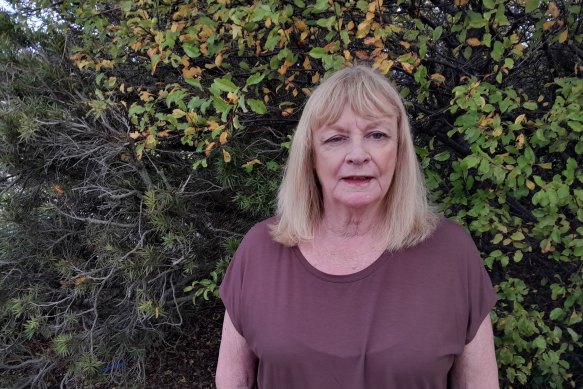By Anna Patty
When Angela Ferrari contacted her bank after a scammer withdrew $97,000 in life savings from her account, she was shocked when asked whether her husband hadn’t taken the money.
“I was a bit horrified and a bit stunned when [the bank representative] mentioned it. My husband is in his 80s, and he still goes to the teller for any banking transactions,” she said.

Angela Ferrari was scammed out of $97,000 and says the bank added to her distress when it asked if her husband was to blame.
The customer complaint comes as the corporate regulator releases a national report on Thursday that found the four major banks have reimbursed only 2 to 5 per cent of customer scam losses.
The Australian Securities and Investments Commission found the banks collectively stopped 13 per cent of scam payments. Of more than $558 million lost by 31,700 customers through scams last financial year, only $21 million was reimbursed.
The findings have fuelled calls from consumer advocates to make banks more accountable for customer scam losses. The Australian Competition and Consumer Commission on Monday revealed that Australians lost a record $3.1 billion to scams last year – an 80 per cent increase compared to the losses the national consumer watchdog reported in 2021.
Ferrari’s husband, Barry, barely uses the internet and Ferrari was “taken aback” when the National Australia Bank had asked if she thought he could have taken the money. She was already thrown after discovering her bank account had been closed and that two large withdrawals of more than $40,000 were made without any phone, email or SMS notifications from the bank.
“I initially thought they were kidding, but [the bank representative] was relentless with it. She asked me a couple of times if it was possible my husband could have done it.”
Someone claiming to be from Optus called Ferrari, 69, in early February offering to help fix her internet connection. As an Optus customer with an unreliable connection she agreed to co-operate by giving the caller access to her computer. The scammer then told her that Optus was offering $550 in compensation which had been deposited to her account. He suggested she check while he fixed her connection. The following day, $97,000 was drained from her savings account.
“There was absolutely no contact made by the bank when that scam occurred,” she said. “It was me that had to call them the next morning when I couldn’t get into my internet account.”
The bank offered a $5000 settlement which Ferrari rejected.
ASIC will today release a report that is critical of the four major banks when it comes to scam detection and their response to customers.
‘Banks need to reconsider the ways they respond to and engage with scam victims to reduce further distress.’
ASIC deputy chair Sarah Court
The national review by the corporate regulator found that banks had contributed to further distress for some scam victims and had taken inadequate action in detecting and stopping scam payments.
ASIC deputy chair Sarah Court said banks needed to improve their management of scams, including their sometimes poor communication with customers during a distressing time.
“Banks need to reconsider the ways they respond to and engage with scam victims to reduce further distress and help them better manage the situation,” she said.
The ASIC report, Scam prevention, detection and response by the four major banks, found bank customers were “overwhelmingly the bearer of scam losses, accounting for 96 per cent of total scam losses across the banks”.

ASIC deputy chair Sarah Court has urged banks to improve the way they handle scams.Credit: Alex Ellinghausen
“Collectively, the banks detected and stopped a low proportion of scam payments made by their customers (approximately 13 per cent of scam payments).”
The ASIC analysis found that scam losses for major bank customers was more than $550 million last financial year, impacting more than 31,700 customers.
The report found the banks had “inconsistent and narrow approaches to determining liability”. Not all scam victims were well-supported by their bank and only 11 per cent of cases involving a scam loss received compensation at three banks for which data was available.
Financial counsellor Claude Von Arx, from the National Debt Helpline and Consumer Action Law Centre, said banks were completely self regulated when it comes to scams.

Financial counsellor Claude Von Arx.
“There are no rules for the recipient banks housing the scammer account and the banks holding the accounts of the victims when a scam has taken place,” he said.
“There need to be very strict rules that banks have to follow across the industry and if they don’t follow them they should be held financially accountable.”
Von Arx said people felt shame and guilt after being scammed and banks had compounded this feeling by suggesting that customers needed to be more aware and better prepared to identify scams.
Consumer Action Law Centre chief executive officer Stephanie Tonkin said the new ASIC report demonstrated the failure of banks to invest enough resources in protecting customers from scams.
“Government must now step in and mandate banks reimbursing customers for scams losses, except in circumstances of gross negligence,” she said. “This is the only way to incentivise the investment needed to tackle the scams crisis in Australia.”
NAB Executive, Group Investigations and Fraud Chris Sheehan said he could not comment on individual cases but said scams continued to rise and had a devastating impact - emotionally and financially.
He said customers should never give an unexpected caller remote access to their computer or online bank accounts.
“When a person believes they have had money stolen, NAB conducts a thorough investigation into the case. Our team then makes every effort to help recover money for customers who have been scammed, but unfortunately these criminals are becoming increasingly sophisticated and once the funds have left an account, it can be extremely hard for us to retrieve them,” he said.
Australian Banking Association chief executive Anna Bligh said it “notes the release of ASIC’s report and Australian banks will consider its contents”. She said banks had already identified the need for more consistency and have been developing an industry-wide standard over the past six months.
“Banks remain committed to the collaborative initiatives commenced as part of the Assistant Treasurer’s Scams Roundtable in February,” she said.
“We also note that ASIC has acknowledged the significant investment by the major banks in anti-scam efforts including a ‘number of innovative and positive initiatives’ completed after ASIC’s review.”
The ABA recently launched a campaign tagged ‘hear the alarm bells’ to raise awareness of scam scenarios and to help customers be more vigilant in spotting scams.
The Morning Edition newsletter is our guide to the day’s most important and interesting stories, analysis and insights. Sign up here.
Most Viewed in Business
"do it" - Google News
April 20, 2023 at 04:34AM
https://ift.tt/ylIsQ6a
‘Did your husband do it?’ $97,000 scam victim shocked at bank question - Sydney Morning Herald
"do it" - Google News
https://ift.tt/MlJzTKq
https://ift.tt/jOzyLP3
Bagikan Berita Ini














0 Response to "‘Did your husband do it?’ $97,000 scam victim shocked at bank question - Sydney Morning Herald"
Post a Comment